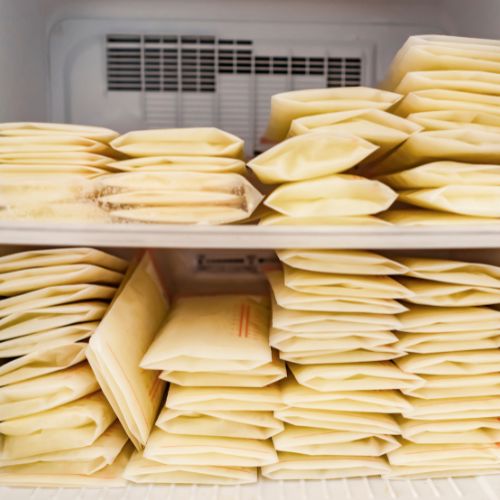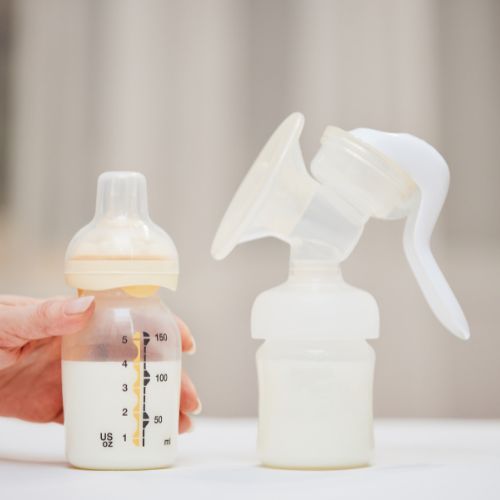Breast milk is often referred to as “liquid gold” – and I want to make sure you aren’t wasting a precious drop! For parents that choose to breastfeed, it’s essential to understand how to properly handle and store breast milk, especially when it comes to reheating. Many parents wonder, “How long does reheated breast milk last?” As a labor and delivery nurse and mom, I will teach you the best way to ensure your baby’s safety when it comes to expressed milk.
Human milk is perfect nutrition for your baby. It contains:
- Macronutrients
- Micronutrients
- Active biologic components, like immunoglobulins, cytokines, hormones, antimicrobial agents, stem and immune cells, pre and probiotics, and growth factors
Whether you are breastfeeding or using a breast pump to feed your baby breast milk, they will reap the benefits! The American Academy of Pediatrics (AAP) recommends exclusive breastfeeding for the first 6 months of life, followed by breastfeeding with food for at least 2 years or more. Keep in mind that this is just a recommendation and may not be possible for all families.
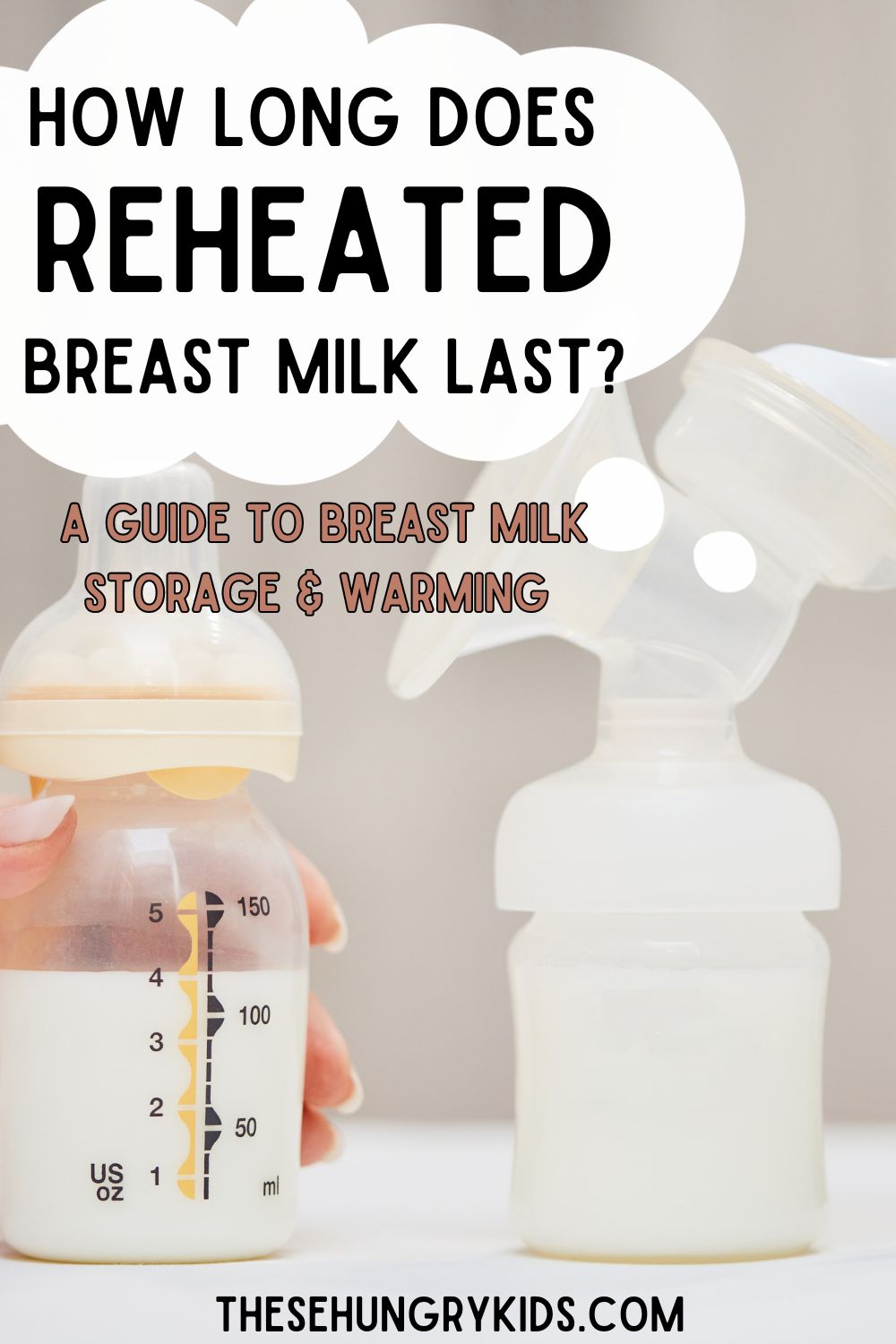
Even a breastfeeding parent may need to use a bottle of breast milk from time to time. It’s always a good idea to keep these best practices somewhere handy, such as saved to your devices or in a printout on the refrigerator.
This post does not contain medical advice and is not meant to replace discussions with your healthcare provider. This post contains affiliate links for your convenience. If a purchase is made using links on this post, I may earn a small commission at no additional cost to you.
Breast Milk Storage Guidelines
Before discussing reheating, let’s discuss the basics of breast milk storage. Whether you are using an electric pump or a manual pump, the guidelines stay the same for fresh milk.
- Room Temperature: Fresh breast milk can be kept at room temperature for up to 4 hours. However, in a warm room (above 77°F or 25°C), it should be consumed within 2 hours.
- Refrigerator (32-39°F or 0-4°C): Breast milk can be safely stored in the refrigerator for up to 4 days. The back of the refrigerator, where the temperature is the most consistent, is the best place for storage.
- Freezer Compartment of a Refrigerator (5°F or -15°C): Breast milk can last for about 2 weeks in the freezer compartment of a refrigerator.
- Freezer with Separate Door (0°F or -18°C): Breast milk can be stored for up to 6 months in a standalone freezer with a consistent temperature. Place in the back of the freezer to keep the milk from warming up slightly when the freezer door is opened.
- Deep Freezer (-4°F or -20°C): Breast milk can be preserved for 6-12 months in a deep freezer with a constant low temperature. It is important to make sure your freezer has a lid that shuts tight. You may want to purchase a freezer alarm (like this one) to ensure proper temperature.
The Centers For Disease Control and Prevention (CDC) has graphics and information listed on their website for breast milk storage guidelines. Click here for the CDC guidelines.
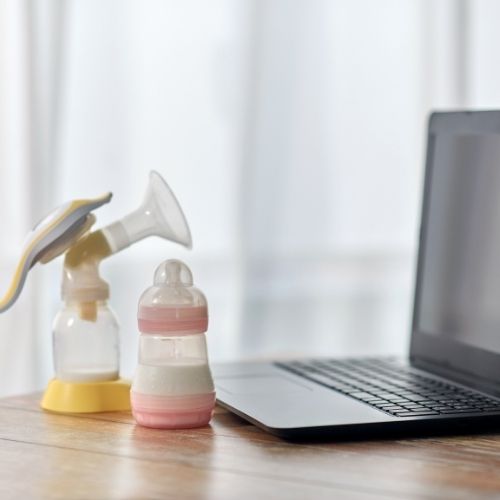
How Long Does Reheated Breast Milk Last?
Now, let’s address the central question: “How long does reheated breast milk last?” Reheated breast milk has a shorter shelf life compared to freshly expressed breast milk.
Once you’ve reheated breast milk or fed baby fresh breast milk from a bottle, it should be used within two hours. Discard any unused milk if not consumed within 1-2 hours, or if the milk develops a foul smell. Leftover breast milk cannot be safely refrozen or mixed with fresh milk for the next feeding.
Here are some general guidelines/ human milk storage information:
- Freshly Expressed Breast Milk: Fresh milk that has not been warmed or reheated can be stored at room temperature for up to 4 hours, in the refrigerator for up to 4 days, in the freezer compartment of a refrigerator for about 2 weeks, and in a deep freezer for 6-12 months.
- Reheated Breast Milk: Once you’ve reheated breast milk, it should be used within two hours. Any remaining milk should be discarded as there is a possibility for bacterial contamination and spoiling.
- Thawed, Previously Frozen Milk: Never refreeze milk after thawing. Place frozen milk bags in the refrigerator and use within 24 hours. Thawed milk can be kept out of the refrigerator for 1-2 hours
When freezing milk, use breast milk storage bags and not a regular plastic bag. This will ensure the inside of the bag is sterile and safe for milk storage. Freeze breast milk in small amounts and warm in small batches to make sure you are not wasting excess milk. Do not fill breast milk to the top of the container, but rather fill only a few ounces at a time and squeeze out any air before freezing.
Only place warmed breast milk in clean breast milk bottles. When traveling with breast milk, use an insulated cooler bag with ice packs. If baby prefers warm milk, the bottle can be heated in a bowl of lukewarm water.
Related: Best Breastfeeding Tips For Producing More Milk
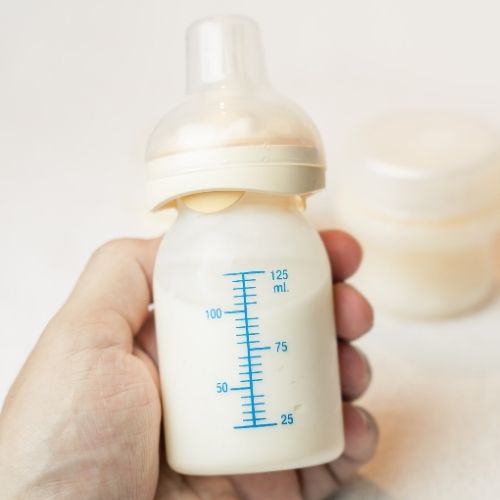
Factors Affecting Reheated Breast Milk
Several factors can affect the safety and quality of reheated breast milk:
- Temperature Fluctuations: Repeatedly heating and cooling breast milk can lead to temperature fluctuations, which may compromise its safety. Avoid reheating the same batch of milk multiple times.
- Bacterial Growth: Breast milk is not sterile, and it may contain some bacteria. When reheated, the milk becomes an ideal breeding ground for bacteria. Discard any milk that has been left at room temperature for more than 2 hours.
- Lipase Enzyme Activity: Some babies may detect a difference in taste when breast milk contains higher levels of lipase enzyme. This enzyme can become more active during storage and reheating. While the milk is still safe to consume, some babies may not prefer the taste. Scalding the milk prior to freezing or adding a drop of alcohol free vanilla may help.
Related: Best Baby Bottles for Breastfed Babies (even if they refuse a bottle)
Reheating Breast Milk Safely
Reheating breast milk requires careful attention to preserve its nutritional value and ensure safety. Heating breast milk must be done with care. Here are the steps to follow for safe reheating:
- Thawing Frozen Breast Milk: If you are reheating previously frozen breast milk, thaw it first. The safest way to thaw frozen breast milk is by placing it in the refrigerator overnight. Alternatively, you can use warm water to thaw it more quickly. Simply place the frozen breast milk in a bowl of warm water or let warm water pour over the milk container to that frozen milk quickly. Do not use the microwave for thawing, as it can create hot spots that may burn your baby’s mouth.
- Use Warm Water: When reheating breast milk, opt for warm water rather than direct heat. Fill a container or bowl with warm water (not boiling), and place the bottle or bag of breast milk in it. Swirl the milk gently to distribute the heat evenly. Do not shake or mix too vigorously! You may also place into a bowl and let warm running water pour over the bag or bottle. Avoid using a microwave or boiling water, as these methods can destroy essential nutrients in the milk and create hot spots that could burn baby’s mouth.
- Bottle Warmers: Bottle warmers are a fast way to warm breast milk. Be careful, however, as some of them use high heat and could make the milk too hot.
- Hot Water Bottle: When traveling, you may wish to bring a thermos of hot water. Use caution not to heat milk too quickly and make sure the milk is not too hot before feeding your baby.
- Check the Temperature: Before feeding your baby, test the temperature of the reheated breast milk by placing a few drops on the inside of your wrist. It should feel comfortably warm, similar to body temperature. Ensure that the milk is not too hot to avoid scalding your baby.
- Use It Within Two Hours: Once breast milk is reheated, it should be used within two hours to ensure its safety and quality. Do not reheat the same batch of milk multiple times, as this can lead to bacterial growth and spoilage.
- Discard Unfinished Portions: If your baby does not consume all the reheated breast milk, discard any leftover milk within two hours. Bacteria from your baby’s mouth can contaminate the milk, making it unsafe for later use.
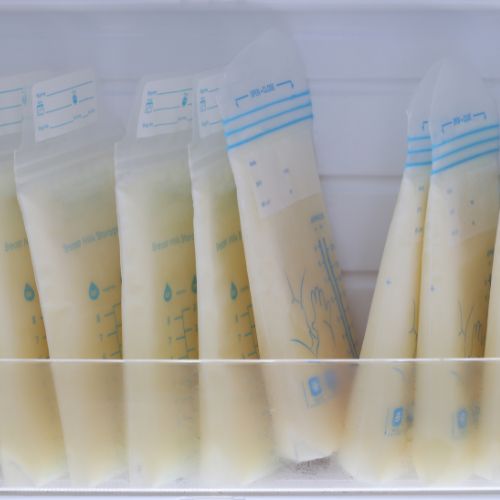
Tips For Storing Breast Milk
- Breast milk storage bags are great for saving freezer space. Squeeze all of the air out of the bag before sealing, label with the date and the amount of milk, and lay flat in the freezer to harden. Once frozen, place in an organizer or storage container with the oldest milk towards the front.
- Wash your bottles and pump parts with warm soapy water and sanitize frequently. This will keep bacteria growth to a minimum. To sterilize, fill a pot of water and bring to a boil or use a bottle sterilizer or sterilizing bags.
- If your child will be under the care of a childcare provider, be sure to mark your bags with your child’s name.
- Be extra careful with babies that are medically fragile, such as those born premature or that had a neonatal intensive care unit stay. Full-term babies are less likely to get sick from spoiled milk, but you should still follow safe storage rules.
- Milk with a foul odor should always be discarded – even if the milk should technically be safe per the guidelines.
- Freeze expressed milk in smaller quantities so you can warm up smaller amounts at a time. Place frozen breast milk bags in a hard plastic container to prevent bags from being punctured or torn in the fridge.
- Always wash your hands before handling breast milk.
- During a power outage, keep freezer doors closed. When power returns, immediately check the milk to ensure it hasn’t thawed. Any thawed milk must be used within 24 hours or discarded.
- Plastic containers (bottles) may scratch and cause bacteria buildup. Consider using glass containers or bottles if your baby is prone to infection.
